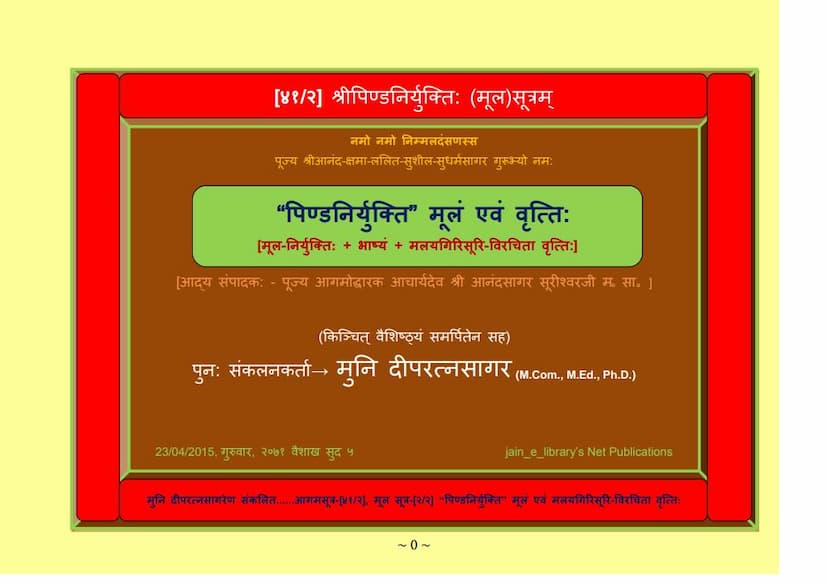Aagam 41 2 PIND NIRYUKTI Moolam Evam Vrutti
Added to library: September 1, 2025

Summary
This text is the Shri Pind Niryukti Moolam Evam Vritti, a Jain scripture. Here's a comprehensive summary based on the provided pages:
Title: Shri Pind Niryukti Moolam evam Vritti (श्रीपिण्डनिर्युक्तिः (मूल)सूत्रम्)
Authors/Editors:
- Original Work: Likely attributed to Shri Bhadrabahuswami (श्रीमद्रबाहुस्वामिप्रणीता) with commentary by Shriman Malayagiri Acharya (श्रीमन्मलयगिर्याचार्यविवृता).
- First Editor: Pujya Agamoddharak Acharya Shri Anandasagarsurishwarji (आगमोध्धारक आचार्यदेव श्री आनंदसागरसूरीश्वरजी).
- Compiler (Re-edited): Muni Diperatnasagar (मुनि दीपरत्नसागर).
Publisher: Deepratnasagar (दीपदीपरत्नसागर) and Shri Devchand Lalbhai Jain Pustakoddhar Bhandagar Sanstha (श्री देवचन्द्र लालभाई जैन पुस्तकोद्धार संस्था).
Catalog Link: https://jainqq.org/explore/004143/1
Core Content and Purpose:
The Pind Niryukti is a commentary or explanation of the Pind-aishana (पिण्डैषणा) chapter, which is the fifth study/chapter within the Dashavaikalika Sutra (दशवैकालिकस्य). The Pind Niryukti itself is a significant Jain text that delves into the detailed examination of "Pind" (पिण्ड), which can be interpreted in several ways within Jain philosophy, including a mass or collection of things, particularly related to sustenance and offerings for monks.
Key Themes and Topics Covered (as indicated by the Table of Contents and text excerpts):
The text is structured to provide a comprehensive understanding of the Pind Niryukti and its associated concepts. The content seems to revolve around:
- The Nature of "Pind" (पिण्ड): The text begins by defining and exploring the various meanings and contexts of the term "Pind," including its synonyms and its application in different situations.
- The "Pind Niryukti" Subject Matter: The core of the text likely outlines the eight main topics (अष्टविधा पिंडनिज्जुत्ति) that the Pind Niryukti addresses. These are presented in the "Vishayan-kram" (विषयानक्रम) and include:
- Udgam (उदगम): Origin or source.
- Utpadana (उत्पादना): Production or creation.
- Aishana (एषणा): Quest or seeking (especially for food/sustenance).
- Sanyojana (संयोजना): Combination or mixing.
- Pramana (प्रमाण): Standard or measure.
- Angara (अंगार): Embers (likely referring to impurities or faults).
- Dhum (धूम): Smoke (likely referring to subtle impurities or consequences).
- Karana (कारण): Cause or reason.
- Nirikshepa (निक्षेप): The text extensively discusses the concept of nikshepa, a method of analyzing a subject through various perspectives (nama, sthapana, dravya, bhava). The Pind Niryukti is analyzed through these nikshepas.
- Categories of "Pind" based on Sentience: A significant portion of the text seems dedicated to classifying "Pind" (or rather, the substances that constitute it) into categories based on their sentience:
- Sachitta (सचित्त): Living or possessing life (e.g., various types of Jiva Kayas like earth-bodied, water-bodied, vegetation-bodied, etc.).
- Achitta (अचित्त): Non-living or inanimate (e.g., earth, water, fire, air, etc., in their inanimate forms, or objects made from them).
- Mishra (मिश्र): Mixed, containing both living and non-living elements.
- Specific Jain Categories (Jiva Kayas): The text likely details the classifications of Pind within the framework of the six Jiva Kayas (living beings/categories of life) and the elements (earth, water, fire, air, vegetation, and sentient beings).
- Detailed Explanation of Principles: The Vritti (commentary) by Malayagiri Acharya provides in-depth explanations of the Niryukti verses, clarifying complex philosophical and practical aspects.
- Specific Terminology: The text uses precise Jain terminology such as nam, apama, upakrama, nikshepa, anu-gama, nay, dravya, bhava, udgam, utpadana, aishana, samyojana, pramana, anga, dhum, karana, vasana, mandana, samkrama, churit, anisa, pratyakhyana, etc.
- Examples and Analogies: The text utilizes examples and stories to illustrate the concepts being discussed, making them more understandable.
- Editorial and Compilation Notes: Muni Diperatnasagar provides context about the publication, its re-editing, and the effort to make the text accessible through digital means. He highlights the importance of adhering to the original text while ensuring clarity.
Significance of this Publication:
This particular publication by Muni Diperatnasagar, compiled from earlier edited versions, aims to preserve and disseminate the profound teachings of the Pind Niryukti. The re-editing and compilation ensure that this important text remains available to a wider audience, particularly in the digital age. The mention of "Jain Education International" and "for private and personal use only" indicates an educational and devotional purpose.
In essence, the Shri Pind Niryukti Moolam evam Vritti is a fundamental Jain text offering guidance on the proper understanding and application of principles related to monastic conduct, sustenance, and ethical considerations within the Jain tradition, as interpreted and elaborated by eminent scholars.